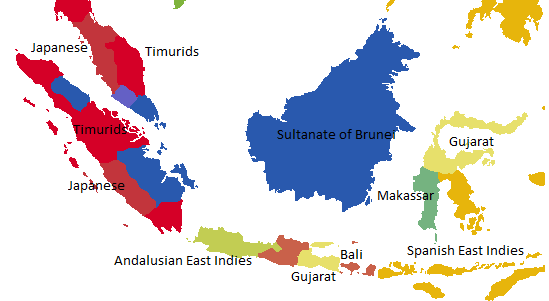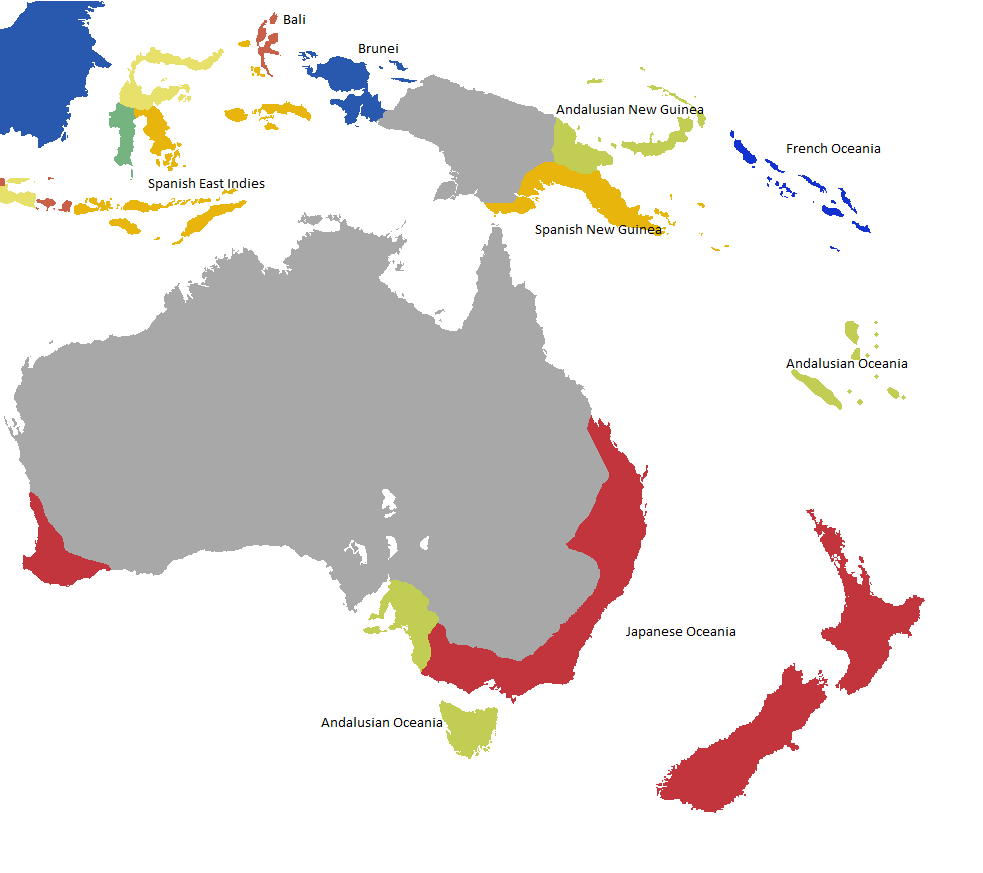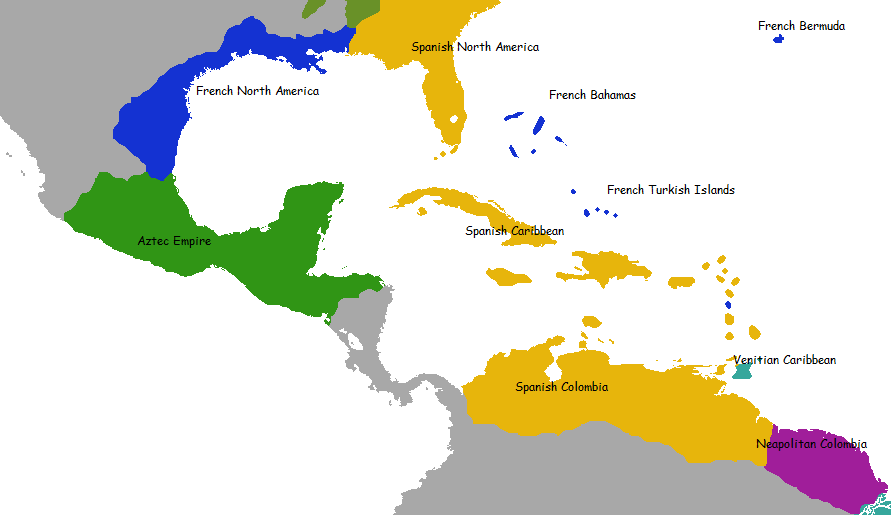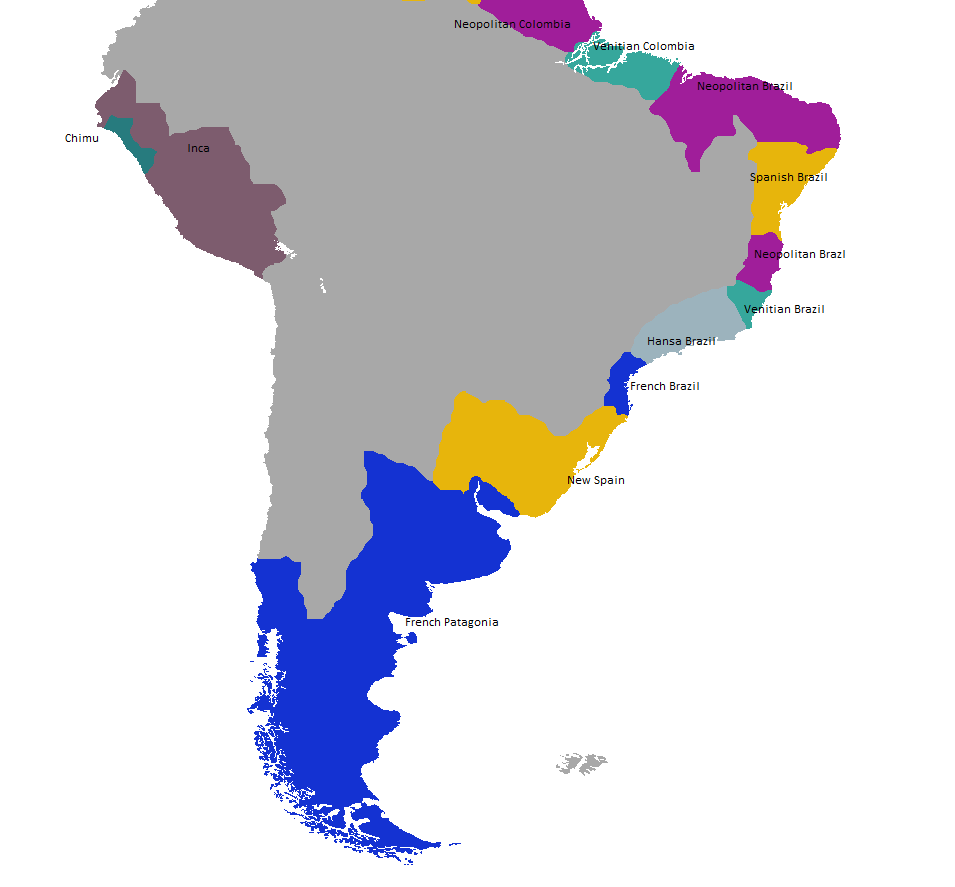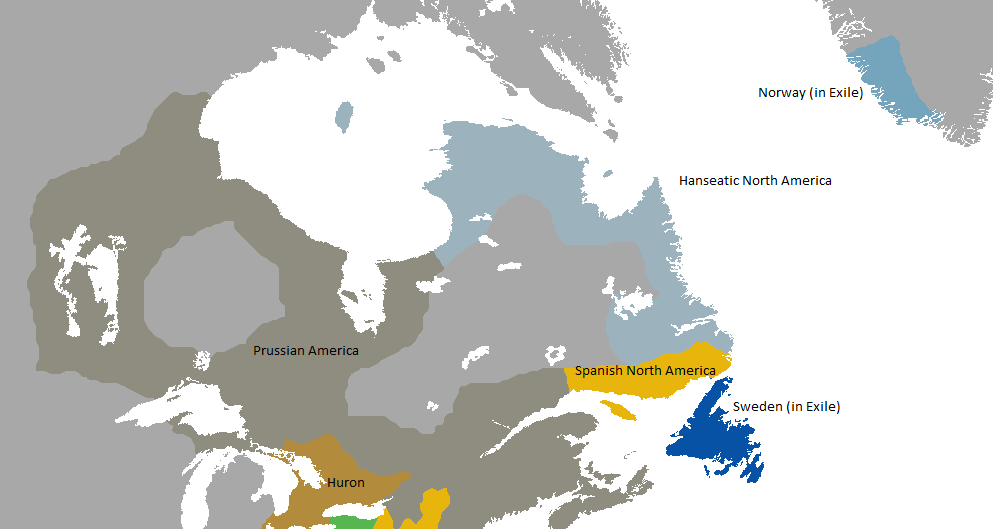Colonialism in the Americas
The Northeast of the Northern American subcontinent is a very interesting place. Originally Prussia had but an edge of the continent while Sweden and Venice divided the rest of the north. This is no longer the case. Prussia has expanded far beyond the confines of the minor peninsula it originally colonized and spread to the west and north. Periodic wars between Prussia and Spain has changed the landscape. Originally the two existed side by side peacefully, but when a war between Sweden and Venice brought in Prussia and Spain on opposite sides the peaceful co-existence between Spain and Prussia ended in the Americas. The latest war ended with a victory for Spain taking two provinces from Prussia. One from the border, and another "reclaimed" on behalf of the Swedes.
Venice was not so lucky inside the engagements having lost its only colony in North America. As Prussia and the other powers swarmed on the position there was little left for them to do but head elsewhere, and head elsewhere they did becoming a very prominent colonizer in Africa and expanding inside South America. The Kingdom of Norway and the Hanseatic League both made their claims on the region, with some success. The Norwegians gained the useful island of Greenland, which the League managed to capture the northeastern most edge of the continent. Sweden's success was limited. Though they managed to take all of their primary colonial site, a rather large island off the coast of the continent, they had lost their sole mainland colony. They were dismayed when Spain had captured the territory, but refused to return it to the Swedes.
Another stroke of bad luck had taken Norway and Sweden and forced them into a position of humiliation, of sorts. When the Swedes and Norwegians had the gaul to attack the Golden Horde, the Khaganate responded with such harshness that the two Kingdoms would be stripped of the entirety of their European holdings by the Khagan. Norway moved voluntarily, seeking Greener shores in the island of green. Sweden needed greater convincing, and this came with the Ango-Swedish war which completely destroyed what remained of their Scandinavian Empire. Then, and only then, did they move to their island. Many Swedes began calling that island their "New found land" and so the island became known as Newfoundland. Both the Norwegians and the Swedes remain in the New World, even if some of their territories revolt and declare allegiance to them out of fear of the Golden Horde. This fear is well founded as the Khagan has a personal dislike for their arrogance.
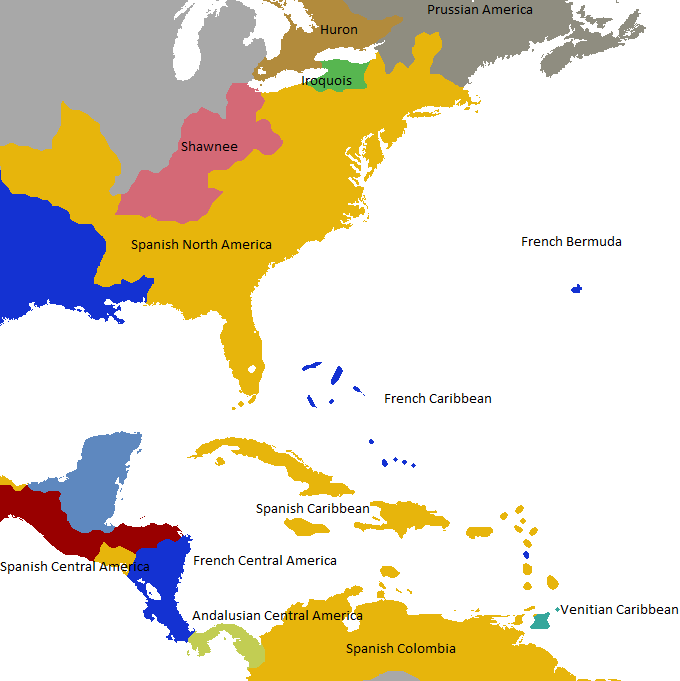
Further South we have a more predictable sight. The Empire of Spain lead by the von Habsburgs continues its drive west. This drive is stymied by the Shawnee peoples. They have been fighting with Spain for well over one hundred years. The Shawnee, however, are fighting a losing battle. Every war sees Spain make greater gains. The Shawnee themselves are rapidly losing the will to fight as they are forced deeper and deeper into their own territory. The Cherokee before them were unable to prevent their own destruction at the hands of the Spaniards, while the Shawnee are stronger than they were that is no guarantee that they will survive. The other great Indian Tribe was that of the Iroquois which had effectively defended against the Spanish and Prussians for almost a century. Often they would play Spain and Prussia off of one another to maintain their own independence.
In fact, the Iroquois would expand three times against the forces of Spain and Prussia, claiming colonies as their own. Unfortunately for them, Prussia and Spain had resolved to crush them because of it. In three separate wars the Iroquois were forced back deeper into the inland of the continent. Capitalizing on a disagreement between the Iroquois leaders, Prussia was able to support a breakaway state from the Iroquois that is now firmly in the camp of the colonizers. The great Iroquois nation is no just a shadow of its former self. Some, however, point to them as inspiration to resist the colonials and use the Huron confederacy as an example of what not to do in case of hardship and disagreements. Even if the Iroquois nation is beaten back and decrepit it still raids the Spanish and vies for a union with the Huron, to unite their quarreling tribes before it is too late for them to stand against them.
For the rest of the territory the Venetians had managed to keep control of Trinidad and Tobago in spite of several wars with the Spaniards and French, the primary owners of the Caribbean. In addition the Emirate of Granada has once again proven itself to be versatile in colonizing the world. The Isthmus connecting the northern and southern subcontinents of the Americas has become part of their domain. It is unknown how exactly they came to have those colonies. Theories abound over the subject. Some claim that Spain and given them the colonies as a reward for their service to the Empire over the many years. Some believe that they were territories captured in one of the many wars, perhaps from a lesser power which the great powers did not approve of. One thing is for certain, with this strategic position the Andalusian colony in North America, no matter how small, is very significant to trade in the region for connecting North to South even if the terrain is hard to traverse.
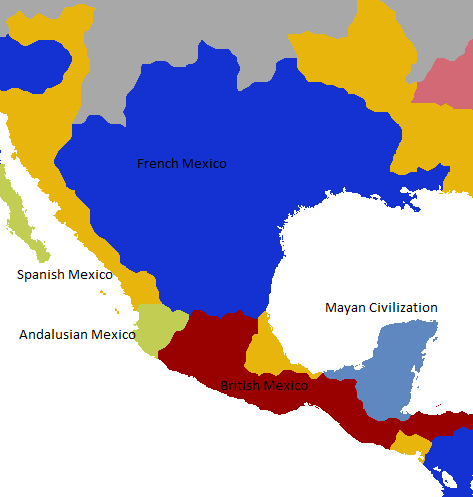
The central region of the northern subcontinent is sometimes referred to as Mexico, a Spanish tainted word that used to come from the natives. This region has been far more chaotic than in the north or in the south. Here there has been a great many genuine wars over control of the region. The French, British, Spanish, and Andalusian quarrel over the region, its gold, its resources, and the prized Pacific coast. Ever since Christopher Columbus set sail to the west in the hopes of finding China the powers of Europe had tried their hardest to acquire a route to the East. As a route was made over the horn of Africa and under Patagonia, now the powers wish to make their claim on the region so that they can catapult their interests into the far east far more easily than they could from the eastern shores of America or on the tiny islands that dot the Indian Ocean.
The main enemy to colonial conquest in the region of Mexico was the Aztec Empire. A powerful state that had defeated all European attempts at conquest. Even Cortez suffered defeat after defeat at the hands of the Aztecs. After it became apparent that in order to beat the Aztecs, you needed to control the territory around it, the French colonized both coasts in an attempt to defeat them. Their attempts ended in failure. Nevertheless French Mexico had expanded vastly. Many people wished to refer to the colony as New France as its population grew and grew. France officially refused to do so and kept it named Mexico. One of four Mexican colonies in the region. Where France had failed, Spain would soon stake their own name on an attempt to conquer the mighty Aztecs.
They failed. But not as spectacularly as the French had. After several years of bloody fighting Spain had managed to get the Aztecs to make a rather small, and minor, concession on their coast. This would become the beginning of the end of the Aztecs. Every seven to ten years a European would attempt to conquer them. The French, the Venetians, the Prussians, and even the Kingdom of Naples would try. They would all fail. The Aztecs had managed to withstand the best that Europe had to offer, but inside their state the Aztecs were beginning to wear down. Their stability was always in shambles. Their army was poorly funded. Their mass sacrifices had further damaged them. The Aztec Emperor had finally resolved to end the practice completely which caused several hard feelings between the Aztec Ruler and the religious theocrats that were under him. For a time the Aztec Emperor managed to control his people and keep the Theocrats at bay, but then the fifth French invasion began.
This French invasion was different from the other ones. France's army was better prepared and their forces were a little stronger, no doubt a sign that France had been right. The key to conquering the Aztecs came with colonizing the region surrounding them. The Aztecs were completely cut off save a single Spanish colony that served no better than harassment. The French had succeeded in conquering most of the region when a single Aztec regiment of three thousand broke through the French line and marched into French territory. This would prove disastrous for the French. Many of their colonies lacked walls to defend them. Some, with insufficient numbers, were either razed to the ground or claimed as sovereign territory of the Aztec Empire. The French were thoroughly humiliated and sent their soldiers back to deal with the Aztec soldiers. It took years to defeat them, but by then the Aztecs had raised a much larger army.
The war continued for several more years before Spain declared war on the Aztecs as well. Ordinarily France would have just been mildly unhappy that a von Habsburg and a de Valois teamed up to take on the Aztecs, but this situation was different. The Aztecs had claimed a large portion of the western coastline. The French themselves were not numerous enough to claim the territory in any real haste and the Aztecs were a constant source of worry. The Aztec Emperor had believed he was about to score the greatest victory a native Empire had ever achieved against a colonial power, but he was wrong. The Spanish army, though smaller, was lead by incredibly talented commanders from their many wars with Prussia and on the continent. These commanders swept through country and would claim all captured colonies for their own. This would give Spain the French west coast, which would the the source of unending conflict between the two.
It was at this time that the Aztec Emperor realized that he was unable to withstand the armies of two of the greatest powers Europe had ever seen, as well as against the allies of the two greatest families inside the entirety of the world. He capitulated for a peace, that was surprisingly generous. Spain merely took three more provinces and had got Spain to renounce their claims on the originally captured territory. The Emperor, counting his blessings, declared the war a victory for his people. To any other nation this would be a defeat, but for the Aztecs to go up against the forces of the world and survive it was indeed no small triumph. Unfortunately for the Emperor his underlings did not agree. With this latest defeat the theocrats rose up everywhere. Particularists, Nobles, Peasants, and Zealots ravaged the country side. He had lost control of his country. It was at this time, the worst of all times, that the British decided to invade.
The British at this time were still lead by the von Habsburgs. The British had failed to establish a colonial empire of their own in the Americas for centuries, which had become the primary concern for the British as they were seen to be second rate colonizers, even put up against their Prussian cousins who controlled some of the more inhospitable terrain. There was a lot of truth to that as for all intents and purposes they were second rate colonizers. This would change with the war with the Aztecs. The Aztec Emperor had no control over his country and the rebels refused to yield to his leadership, which was for all intents and purposes some of the best in the world at the time. The British landed with only minor difficulties against disorganized nobles, peasants, particularists, and zealots. Within mere months the entirety of the great Aztec Empire was occupied.
A horrendous peace followed as more than half of the country was taken by the British. Instead of uniting as one against the British, who were by no means as benevolent as their Habsburg cousins in Spain, they pushed the blame entirely on the Emperor. Now the Emperor could have done nothing for the people who refused to follow him, and now the Emperor could do nothing as the state fell into an even greater state of disrepair. This time the powers of the land had regicide on their mind. The Aztec Emperor was killed in a coup, as were all fourteen of his children. His younger brother would flee to the Yucatan Peninsula where he would ally with the Spaniards who would invade the remnant Aztec Empire. This Empire, now existing solely in name, fell to the Spaniards who set up the rival Mayan Empire to the Aztecs. Shortly after the British would invade yet again and conquer what remained of the Aztecs.
The actual Aztec Empire may have been defeated, but the Empire lives on with the Mayans. The Mayans are ruled by the Aztec Dynastic line even if they are not Aztec in terms of culture. The Maya would be a completely different civilization from the Aztecs, but be the same in many ways. This Mayan Empire is an ally of the Spanish and will, for all intents and purposes, survive the onslaught of time where other native peoples had failed. That is, so long as they remain allied to their Spanish Patron. It is unknown if the British or the French will invade the small country, but until they do the Mayans will remain at peace.
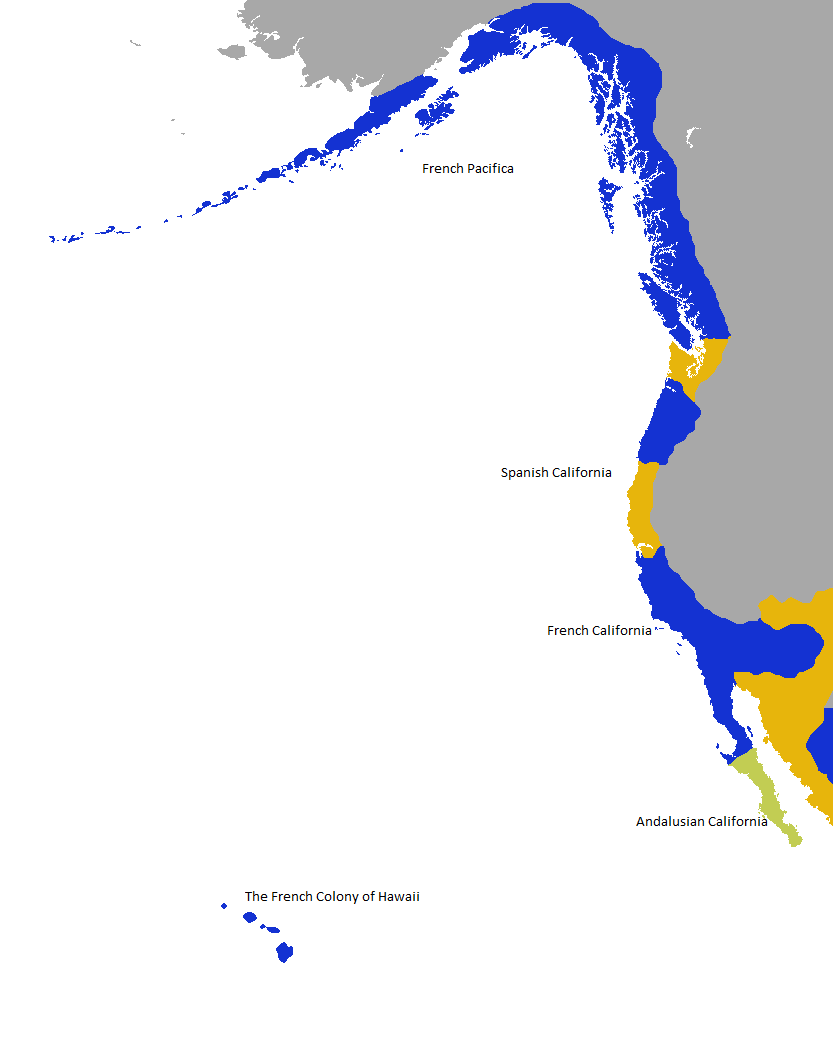
The last part of the northern sub continent is much more divided. This region has not had centuries to develop into nicely organized territories. Much of it remains roughly done. Wars between the Spanish Empire and the French Empire remain commonplace. The entire west coast of the northern sub continent is referred to as either Pacifica or California. Pacifica is so named because of the ocean it borders in much the same way that some people referred to early Atlantic colonies as Atlantis. The idea of California has a more interesting origin. Originally California was the same thing as Mexico, but after Spain had claimed enough land to divide the French colony of Mexico into two regions, and the sheer length of time to communicate between the French west Mexico to east Mexico the French decided to divide Mexico into California and Mexico. The name apparently caught on as both Spain and Andalusia would claim to have colonies named California, most of which were captured from France.
French Pacifica came about after the French Empire claimed the region under the valiant admiral Petain. The region has a valuable fur trade as well as enjoys close relations to the Golden Horde's Siberian territories in the far east. Spain has fought France several times over the region but in all cases France remains far too stubborn to give up Pacifica. It was not all wars, however. France became the first nation to link the American colonies to the Oceanian colonies by claiming the Kingdom of Hawaii as a colony and using it as a naval base, with its natural harbors, to coordinate communications and traveling between regions. Spain shows no official interest in the island chain preferring to capture more strategic territory for trade with the lucrative Khaganate market.
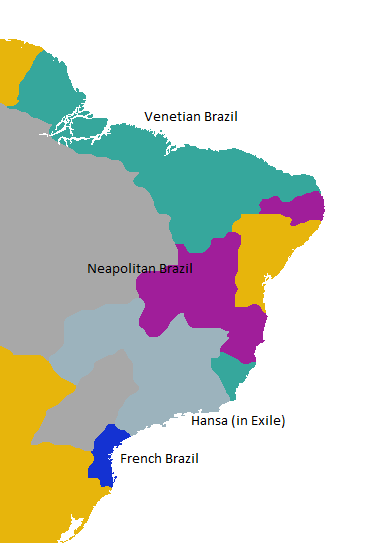
The Eastern regions of the southern sub continent has been a hot bed of activity between the Republic of Venice, the Hanseatic League, and the Kingdom of Naples. Spain and France have been known to intervene as they see fit in the region. Venice's colonies were always in constant conflict with that of Naples. Venetian Colombia was surrounded by Neapolitan Colombia and Brazil. Over a period of several decades of warfare Venice had become supreme inside the conflict, but not completely so. Neapolitan Colombia ceased to exist as it was absorbed into Venetian Colombia. In addition the northern half of Neapolitan Brazil was ceded to Venice. With this new development Venice merged Venetian Colombia with Venetian Brazil, with the main seat of Venetian Brazil shifted to the northern territories. Since Brazil's transition to the African coast, the security of Brazil has become a top priority.
Naples, however is facing problems of their own. Before they were a dominant power in Europe, but now it has become apparent that they are a waning empire. France had intervened on the behalf of Venice inside the conflict with Naples. Unfortunately what was just a colonial squabble soon involved a French invasion of Naples itself. After being soundly defeated France had taken territory belonging to Naples for hundreds of years. Later Spain would declare war on the nation yet again and would follow France's president by taking a colonial disagreement to Naples, this time forcing it to cede a province and grant Sicily independence. With this it became apparent that Naples could not afford to stay in Europe much longer, but with Brazil a hotbed of wars were could they go? The Monarchy, for now, remains in their traditional seat of power in the city of Napoli. Only time will tell if the city will fall to another power.
The Hanseastic League is another interesting case. Unlike Venice who retreated under rather dire circumstances but remaining in control of their capital, or like Sweden or Norway that witnessed the empire crumble before retreating, but refusing to return even when their homeland becomes independent again, the Hanseatic league fled from Europe in the face of annexation. The Empire of France and the insidious de Valois had their eyes on Lubeck and would take the city. Hansa didn't retreat because it wished to be safe, it retreated because their great city was sacked and occupied by France. Without a single European holding left, the Hanseatic League has become a state focused on keeping what little it has. In the North this involves keeping the most frigid and unwanted of provinces. To the south it includes staying far out of the way of Spain and France and engaging in only the tiniest of squabbles with Venice.
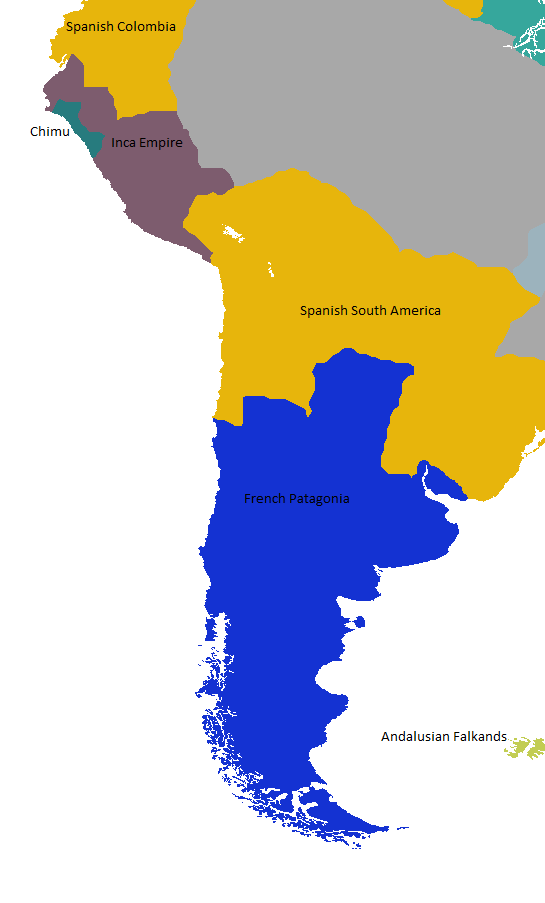
Inside the western part of the southern sub continent things have progressed predictably for the most part. France has monopolized Patagonia claiming a large portion of the southern part of the southern sub continent. Spain has driven west, as it has with its northern territories and south from Colombia. Now they control almost the entirety of the sub continent apart from the Brazilian colonies and French Patagonia, one being too full of diverse nationalities to bother with and the other too powerful to take outright. This leaves the Empire of the Inca, which has proven itself to be even more resourceful and powerful than the Aztecs. Their downfall, however, has been their inaction. The Inca has been content to merely control their lands and have shown no drive to take on the Spanish. Instead the Inca and their client state the Chimu have merely gone to war with the Europeans when they have already declared wars on them.
Each time, however, they have proven themselves to be exceptional warriors. The Spanish forces are unable to truly defeat the stable Inca Empire. And since the Inca are far away from the French and other European powers, the Inca hasn't had to worry about succumbing to the same situation that the Aztecs did. Unfortunately for the Inca, as the world becomes more developed their isolation effectively ceases to exist. The Inca are also known to be prominent for their conversion to Catholicism. Very few Inca actually follow the faith, however. Even so it has nevertheless proven to be an excellent deterrent from most of the European Powers even if they will never recognize them as an equal. The Papacy has declared the Inca a sovereign and educated people, unlike the pagan and animist heathens that the European powers continue to conquer relentlessly. Only time will tell if the Inca can survive another seventy-five years.
If you do make that tweak to the HRE you were planning to, I'd like to have the code.



